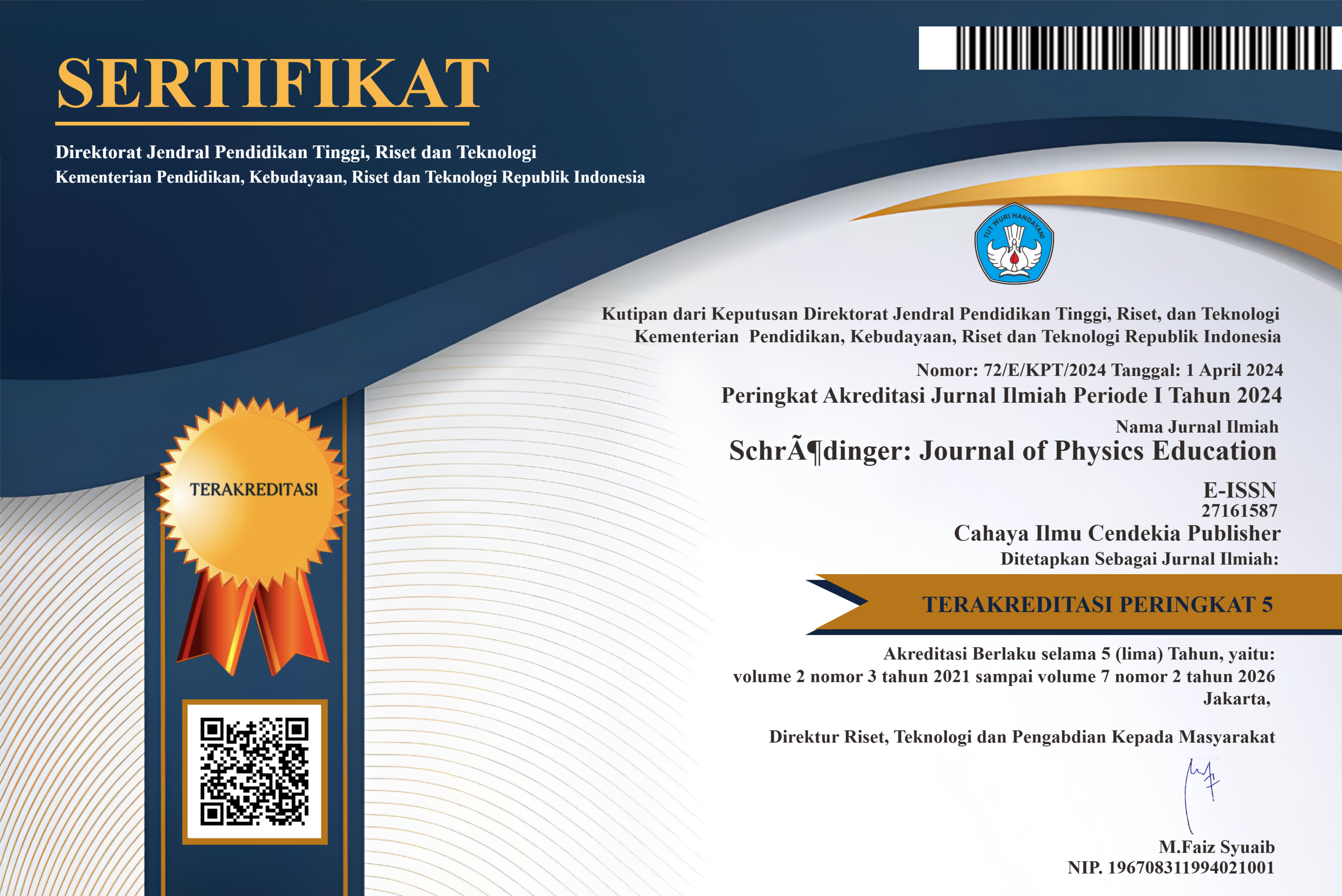Improving Student Learning Outcomes on Earth Layers Material by Using Audio Visual Media
Abstract
Purpose of the study: The researcher aims to determine the increase in student learning outcomes in the earth's layers material by using audio-visual media.
Methodology: This research is classroom action research. The subjects in this research were 7th grade students with a total of 39 students using a simple random sampling technique. The data collection instruments in this research consisted of multiple choice questions, observation sheets for teachers and students and documentation. Data analysis uses descriptive statistical analysis.
Main Findings: The results of this research found that by using audio visual media students were more enthusiastic in participating in learning and with the help of discussion methods students were more active and discussing with groups, with audio visual media students' learning outcomes also increased, from the learning of each cycle in class VII F students a number There were 39 students who had not achieved learning completeness, 20 students in cycle I and 2 students in cycle II. After implementing the learning actions, there were still 2 students whose scores were less than 75 or had not reached the minimum completeness criteria of 75. Then these students were given further study guidance and given remedial measures.
Novelty/Originality of this study: The novelty of this research is that it shows adaptation to students' learning styles or individual needs in the context of earth layer material, this can be considered an innovative step. A personalized learning approach can increase learning effectiveness.
References
Herpratiwi and A. Tohir, “Learning Interest and Discipline on Learning Motivation,” Int. J. Educ. Math. Sci. Technol., vol. 10, no. 2, pp. 424–435, 2022, doi: https://doi.org/10.46328/ijemst.2290.
A. Brown et al., “The Creation of a Nudging Protocol to Support Online Student Engagement in Higher Education,” Act. Learn. High. Educ., vol. 24, no. 3, pp. 257–271, 2023, doi: http://dx.doi.org/10.1177/14697874211039077.
A. S. A. Ghani, A. F. A. Rahim, M. S. B. Yusoff, and S. N. H. Hadie, “Effective Learning Behavior in Problem-Based Learning: a Scoping Review,” Med. Sci. Educ., vol. 31, no. 3, pp. 1199–1211, 2021, doi: 10.1007/s40670-021-01292-0.
A. Ekasari and Maulidinah, “Application of E-Module to Identify Students ’ Science Process Skills in the Practicum of Refraction on Prisms,” Schrödinger J. Phys. Educ., vol. 4, no. 2, pp. 30–35, 2023, doi: 10.37251/sjpe.v4i2.502.
K. Rathnasekara, N. Suraweera, and K. Yatigammana, “The Impact of Self-Efficacy Beliefs of Employees on Contextual Issues of Online Learning: With Reference to the Banking Sector in Sri Lanka,” Asian Assoc. Open Univ. J., vol. 18, no. 1, pp. 1–19, 2023, doi: http://dx.doi.org/10.1108/AAOUJ-12-2022-0177.
M. T. Hidayatullah, M. Asbari, M. I. Ibrahim, and A. H. H. Faidz, “Urgensi Aplikasi Teknologi dalam Pendidikan di Indonesia,” J. Inf. Syst. Manag., vol. 2, no. 6, pp. 70–73, 2023, doi: https://doi.org/10.4444/jisma.v2i6.785.
C. Fandos-Herrera, C. Herrando, J. Jiménez Martínez, and J. M. Pina, “Discuss to Learn: A Student-Focused Learning Strategy,” Educ. Train., vol. 65, no. 5, pp. 697–710, 2023, doi: http://dx.doi.org/10.1108/ET-02-2022-0049.
A. G. Nugroho and L. Latifah, “Proses Pembelajaran Menggunakan Strategi Inkuiri Dalam Manajemen Berbasis Sekolah (Mbs) Dengan Hasil Kepuasan Guru Di Madrasah Tsanawiyah Assalam Martapura,” AL-ULUM J. Ilmu Sos. dan Hum., vol. 8, no. 2, 2022, doi: http://dx.doi.org/10.31602/alsh.v8i2.8246.
I. E. Ramadha and A. Zuhaida, “Peningkatan Hasil Belajar IPA melalui Model Pembelajaran Problem Based Learning dengan Media Flash Card,” J. Classr. Action Res., vol. 3, no. 2, 2021, doi: https://doi.org/10.29303/jcar.v3i2.834.
W. Setioko and L. Ding, “Influence of Parents’ Views about Science on Parent-Child Science Talk at Home,” Int. J. Sci. Educ. Part B Commun. Public Engagem., vol. 13, no. 3, pp. 195–215, 2023, doi: http://dx.doi.org/10.1080/21548455.2022.2153094.
E. S. Oztay, S. Aydin Gunbatar, and B. Ekiz Kiran, “Assessing chemistry teachers needs and expectations from integrated STEM education professional developments,” J. Pedagog. Res., vol. 6, no. 2, pp. 29–43, 2022, doi: 10.33902/jpr.202213478.
Rusmini, Suyono, and R. Agustini, “Analysis Of Science Process Skills Of Chemical Education Students Through Self-Project Based Learning (Sjbl) In The Covid-19 Pandemic Era,” J. Technol. Sci. Educ., vol. 11, no. 2, pp. 371–387, 2021, doi: 10.3926/jotse.1288.
E. Triani, Darmaji, and Astalini, “Identiifikasi Keterampilan Proses Sains dan Kemampuan Berargumentasi,” J. Pendidik. dan Pembelajaran IPA Indones., vol. 13, no. 1, pp. 9–16, 2023, doi: 10.23887/jppii.v13i1.56996.
B. Widodi, Darmaji, and Astalini, “Identifikasi Keterampilan Proses Sains Dan Kemampuan Berpikir Kreatif Siswa,” J. Pendidik. dan Pembelajaran IPA Indones., vol. 13, no. 1, pp. 1–8, 2023, doi: 10.23887/jppii.v13i1.57131.
Astalini, Darmaji, D. A. Kurniawan, S. W. Oktavia, E. Triani, and M. Z. Azzahra, “The Exploration of Character Values in Physics Learning on Momentum, Impulse, and Collision Materials,” J. Educ. Res. Eval., vol. 7, no. 2, pp. 277–284, 2023, doi: 10.23887/jere.v7i2.52381.
Ö. V. Yaz and M. A. Kurnaz, “Comparative Analysis of the Science Teaching Curricula in Turkey,” SAGE Open, vol. 10, no. 1, 2020, doi: 10.1177/2158244019899432.
S. Ilma, M. H. I. Al-Muhdhar, F. Rohman, and M. S. Sari, “Promoting students’ metacognitive awareness and cognitive learning outcomes in science education,” Int. J. Eval. Res. Educ., vol. 11, no. 1, pp. 20–30, 2022, doi: 10.11591/ijere.v11i1.22083.
E. Purwanti and H. Heldalia, “Critical Thinking Ability: Analysis of Flat Mirror Reflection Material,” Schrödinger J. Phys. Educ., vol. 4, no. 1, pp. 12–17, 2023, doi: 10.37251/sjpe.v4i1.493.
Darmaji, Astalini, D. A. Kurniawan, and B. Widodi, “The relationship between science process skills and students’ creative thinking skills at the Nurul Ilmi 1 Islamic Junior High School on Magnetism material,” J. Pedagog. Dan Pembelajaran, vol. 5, no. 3, 2022, doi: https://ejournal.undiksha.ac.id/index.php/JP2/article/view/48636.
M. Dwi, W. Ernawati, A. Sanova, D. A. Kurniawan, and E. Triani, “Students ’ Attitude Towards Science and Its Implications on Science Learning Outcomes of Junior High School Students,” J. Pendidik. Progresif, vol. 12, no. 2, pp. 898–911, 2022, doi: 10.23960/jpp.v12.i2.20223.
F. T. Nomleni and T. S. N. Manu, “Pengembangan Media Audio Visual dan Alat Peraga dalam Meningkatkan Pemahaman Konsep dan Pemecahan Masalah,” Sch. J. Pendidik. dan Kebud., vol. 8, no. 3, pp. 219–230, 2018, doi: 10.24246/j.js.2018.v8.i3.p219-230.
A. M. Nawahdani, E. Triani, M. Z. Azzahra, M. Maison, D. A. Kurniawan, and D. Melisa, “Hubungan Minat dan Motivasi Belajar Siswa terhadap Mata Pelajaran Fisika,” J. Penelit. dan Pengemb. Pendidik., vol. 6, no. 1, pp. 12–18, 2022, doi: 10.23887/jppp.v6i1.41986.
N. Apriyanti, R. A. Razak, M. S. Nizam, S. Syrene, A. Rahim, and S. H. Halili, “Needs Analysis Of Infographic Media Using Technology for Learning Physics,” Malaysian Online J. Educ. Technol., vol. 8, no. 1, pp. 48–62, 2020, doi: 10.17220/mojet.2020.01.004.
L. Rosdiana and R. M. Ulya, “The Effectiveness of the Animation Video Learning Earth’s Layer Media to Improve Students’ Concept Understanding,” J. Phys. Conf. Ser., vol. 1899, no. 1, 2021, doi: 10.1088/1742-6596/1899/1/012172.
C. Dyah, S. Indrawati, P. Ninghardjanti, C. Huda, and A. Dirgatama, “The effect of practicum learning based audiovisual on students ’ learning outcomes in Indonesian vocational secondary school,” Int. J. Eval. Res. Educ., vol. 11, no. 1, pp. 403–408, 2022, doi: 10.11591/ijere.v11i1.21762.
M. D. Abdulrahaman et al., “Multimedia tools in the teaching and learning processes: A systematic review,” Heliyon, vol. 6, no. 11, p. e05312, 2020, doi: 10.1016/j.heliyon.2020.e05312.
S. Suharsiwi, N. Fadilah, and L. Farokhah, “The Use of Audio-Visual Media in Improving Students’ Reading Comprehension and Sholat Movements in Online Learning,” J. Educ. Technol., vol. 6, no. 1, pp. 19–28, 2022, doi: 10.23887/jet.v6i1.40797.
C. Nicolaou, M. Matsiola, and G. Kalliris, “Technology-Enhanced Learning and Teaching Methodologies through Audiovisual Media,” Educ. Sci., vol. 9, no. 1, pp. 1–13, 2019, doi: 10.3390/educsci9030196.
L. Mufidah, “Urgensi Penelitian Tindakan Kelas Dalam Memperbaiki Praksis Pembelajaran,” At-Tajdid J. Pendidik. dan Pemikir. Islam, vol. 4, no. 02, p. 168, 2021, doi: 10.24127/att.v4i02.1426.
M. Öztürk and Ü. Çakıroğlu, “Flipped learning design in EFL classrooms: implementing self-regulated learning strategies to develop language skills,” Smart Learn. Environ., vol. 8, no. 1, 2021, doi: 10.1186/s40561-021-00146-x.
G. Ayaya, T. M. Makoelle, and M. van der Merwe, “Participatory Action Research: A Tool for Enhancing Inclusive Teaching Practices Among Teachers in South African Full-Service Schools,” SAGE Open, vol. 10, no. 4, 2020, doi: 10.1177/2158244020963576.
R. Huang, A. Tlili, T. W. Chang, X. Zhang, F. Nascimbeni, and D. Burgos, “Disrupted classes, undisrupted learning during COVID-19 outbreak in China: application of open educational practices and resources,” Smart Learn. Environ., vol. 7, no. 1, 2020, doi: 10.1186/s40561-020-00125-8.
A. Van Den Beemt, M. Thurlings, and M. Willems, “Towards an understanding of social media use in the classroom: a literature review,” Technol. Pedagog. Educ., vol. 29, no. 1, pp. 35–55, 2020, doi: 10.1080/1475939X.2019.1695657.
N. L. Andriyani and N. W. Suniasih, “Development of Learning Videos Based on Problem-Solving Characteristics of Animals and Their Habitats Contain in Ipa Subjects on 6th-Grade,” J. Educ. Technol., vol. 5, no. 1, p. 37, 2021, doi: 10.23887/jet.v5i1.32314.
L. Bajrami and M. Ismaili, “The Role of Video Materials in EFL Classrooms,” Procedia - Soc. Behav. Sci., vol. 232, no. April, pp. 502–506, 2016, doi: 10.1016/j.sbspro.2016.10.068.
O. O. Olagbaju, A. G. Popoola, A. G. Effects, O. O. Olagbaju, and A. G. Popoola, “Effects of Audio-visual Social Media Instruction on Learning Outcomes in Reading To cite this article : Effects of Audio-visual Social Media Resources-supported Instruction on Learning Outcomes in Reading,” Int. J. Technol. Educ., vol. 3, no. 2, pp. 92–104, 2020, [Online]. Available: https://eric.ed.gov/?id=EJ1264146
T. A. Pranowo and A. Prihastanti, “Pengaruh Bimbingan Kelompok Melalui Media Audio Visual Terhadap Motivasi Belajar Siswa,” Indones. J. Learn. Educ. Couns., vol. 2, no. 2, pp. 217–223, 2020, doi: 10.31960/ijolec.v2i2.338.
W. Winarto, A. Syahid, and F. Saguni, “Effectiveness the Use of Audio Visual Media in Teaching Islamic Religious Education,” Int. J. Contemp. Islam. Educ., vol. 2, no. 1, 2020, doi: 10.24239/ijcied.Vol2.Iss1.14.
F. Tuma, “The use of educational technology for interactive teaching in lectures,” Ann. Med. Surg., vol. 62, no. December 2020, pp. 231–235, 2021, doi: 10.1016/j.amsu.2021.01.051.
A. nisa N. S. Indah Septiani, I. Septiani, T. Rejekiningsih, Triyanto, and Rusnaini, “Development of interactive multimedia learning courseware to strengthen students’ character,” Eur. J. Educ. Res., vol. 9, no. 3, pp. 1267–1279, 2020, doi: 10.12973/eu-jer.9.3.1267.
Copyright (c) 2024 Annisa Fatonah, Hassen Worku, Francis Inyang

This work is licensed under a Creative Commons Attribution 4.0 International License.
Authors who publish with this journal agree to the following terms:
- Authors retain copyright and acknowledge that the Schrödinger: Journal of Physics Education is the first publisher licensed under a Creative Commons Attribution 4.0 International License.
- Authors are able to enter into separate, additional contractual arrangements for the non-exclusive distribution of the journal's published version of the work (e.g., post it to an institutional repository or publish it in a book), with an acknowledgment of its initial publication in this journal.
- Authors are permitted and encouraged to post their work online (e.g., in institutional repositories or on their website) prior to and during the submission process, as it can lead to productive exchanges and earlier and greater citation of published work.







.png)
.png)








.png)
.png)
.png)








